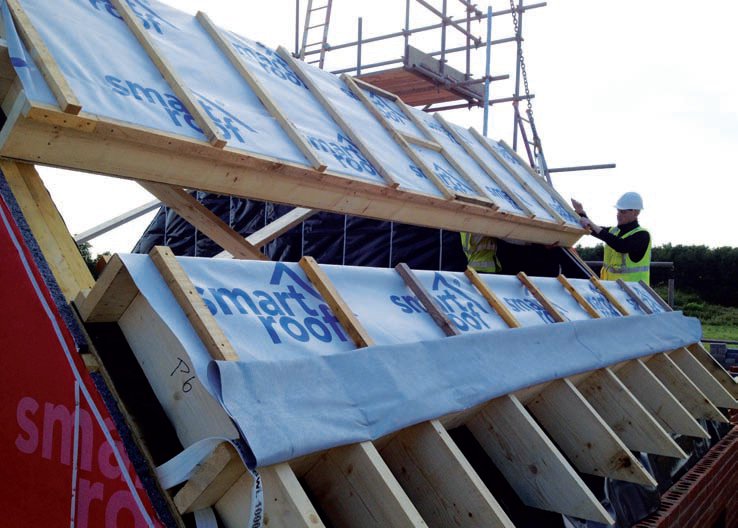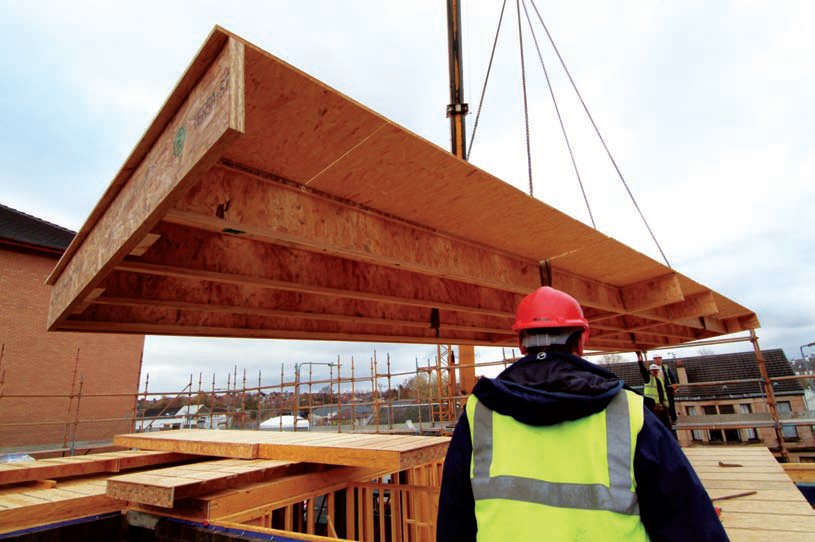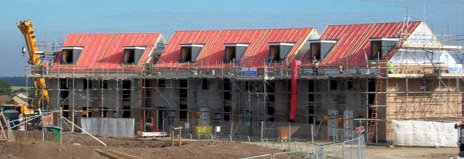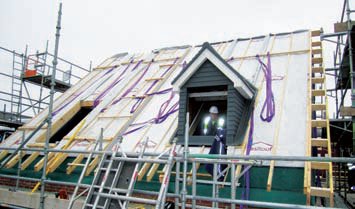All systems are go
25 January 2014Floor, wall and roof system manufacturers and their suppliers are seeing an upturn in the construction method. Sally Spencer reports.
In common with the whole construction sector supply chain, manufacturers and distributors of floor, wall and roof systems found 2013 to be a year of two halves - one minute economists were forecasting a tripledip recession, the next the government's Help to Buy scheme lit the blue touch paper and we were off.
"The first three or four months of 2013 were as tough as it's been since the start of the recession," said Pasquill managing director Stuart McKill. "But there was a surge of activity in the middle part of the year and we find ourselves in quite a different place now."
As a result, he continued, the company had to change up into top gear pretty swiftly, recruiting both temporary and new labour in order to "man up" its plants and satisfy the sudden increase in demand.
It's by no means an isolated case, either.
"As an industry it's been a battle to keep up with demand, from all angles," said Tim Widdershoven, marketing manager at ITW Industry. "One of the side effects [of the upturn] and the brick and block shortage is a pick-up in demand for spandrel panels and gable panels. That's been great for our fabricator [customers], one of whom said he'd seen a six-fold increase in spandrel panel sales.
Investment and recruitment
"It's been positive for us but in order to keep up with demand we've had to invest about £400,000 in new presses and tooling and we've had to employ new staff and increase shifts. We're having to use every resource available to us to keep up with demand. And we don't see this as a blip - we're confident it's sustainable."
I-joists and metal-web joists continue to be a mainstay of floor, wall and roof systems and both products have their champions.
I-joist manufacturers feel their products survived the recession somewhat better than metal-web joists, thanks to their cost-competitiveness.
"Some social projects have changed to I-joists because of the price difference compared to metal-web joists - which can be between 40-100%," said Andy Moore, managing director of Steico UK, which manufactures the SteicoJoist. "And since the summer [of 2013] demand has improved by about 20%."
Improving market
Neil Lewis, national product manager for engineered timber at Crown Timber plc, which distributes Boise's products, including the BCI-Joist, agrees. "The market has been rising since the middle of 2013 and the nature of an I-joist cutting operation means that it's more able to be scalable relative to demand, making them the more cost-effective solution."
"Large section ducting can easily be inserted into the thin web of an I-joist and metalwork solutions are available in the few instances where additional support is required," said Mark Tilston, business development manager at James Jones & Sons, which manufactures the JJI-Joist.
Metal-web manufacturers and system providers, however, see their market share improving. Wolf Systems business development manager Paul Flounders cites its customers' continuing investment in metalweb joist machinery as evidence of this, while MiTek Industries business development director James Morgan points to "a number of the national housebuilders moving across to metal-web joists to gain the benefits of improved and easier access for services".
Meanwhile, at ITW Industries, an upturn in nailplate sales indicates a general increase in construction activity but these are being outperformed by metal-web joist sales, leading the company to conclude that the latter is gaining ground.
"You could argue that housebuilders have returned to profit and now have the opportunity to buy a premium system," said Paul Baron, commercial manager Alpine and Gang-Nail. "And equally, as the years have progressed the builders have used up all their sites that had Building Regulations pegged back to 2004-2006 and now they're having to use sites where Building Regulations are more current and there is more of a demand for running services such as mechanical ventilation and heat recovery ducting through the floors."
Cassette solutions
More of these joist products are being supplied for cassette-type solutions. "A major driver for this is de-skilling on site," said Mr Moore. "To ensure performance, for example, roof cassettes are often supplied with insulation and everything fitted except the tiles."
Crown's Neil Lewis agrees that offsite manufacture provides more accuracy in the placement of structural and insulation material, "leading to a more predictable end product". It also, he added, reduces site time and installation is less weather dependent. Health and safety is another consideration.
"We reckon that around 3% of newbuild has this type of roof construction," said Mr Baron. "But if 130,000 houses are being built this year that's still 3,500 [with roof cassettes] so while it might not be your bread and butter, you wouldn't want to ignore it."
The systems approach is well established in floors and gaining ground in roof and wall construction.
Smartroof, the gable-to-gable interlocking panel system that resulted from a collaboration between Wolf Systems and timber engineering manufacturer Wyckham Blackwell, is experiencing "tremendous growth year on year", according to its business development manager Matthew Naughton.
"The increase in the quantity of room-inthe- roof [RiR] houses being plotted and a greater market share being taken from traditional RiR methods has been a key factor," he said. "And the industry is shifting to more off-site solutions, reducing the effect on programme due to inclement weather."
He added that great improvements had been made to the smartroof system over the last couple of years. "Our build time has improved for both factory and site, our engineering/connection details are simplified and our design capabilities are broader, giving us greater scope in the roof styles and sizes we can achieve," he said.
This year will see further product development as engineered joists will be introduced into the panels and a higher degree of prefabrication will be demonstrated.
Roof and wall systems
"Roofs probably account for 15% of our I-joist sales and are the fastest growing area while walls are still seeing slow growth," said Steico's Andy Moore, while for Boise/Crown, although roof enquiries are forming a significant part of the overall mix, walls, although small volumes right now "are showing the biggest year-on-year increase individually, due to tightening regulations and eco-conscious clients," according to Neil Lewis.
"Floors are still the main market, with national and regional builders taking full advantage of the value-added and guaranteed performance that I-joists offer," said Mark Tilston. "But we are continually seeing an increase in deep joist sales for large open-span roofs with high insulation requirements - hence our launch of deeper section joists last year.
"There has also been a marked increase in uptake of our JJ-IntelliRoof system through our partners RoofSpace Solutions, who are marketing the system as I-Roof and are supplying several of the major housebuilders (see panel). There is also growing interest and increasing sales for preservative-treated joists for I-Stud wall solutions and refurbishment projects."
I-joists would seem to have the advantage over metal-web joists in wall solutions, with the latter felt to be "over-engineered" for this application. ITW Industries' SpaceStud does not feature the company's metal-web SpaceJoist, for example, but is a product specifically designed for wall construction.
"Walls remain an emerging market for metal webbed components as the thermal performance delivered by the wide wall studs is way beyond current regulation requirements," said MiTek's James Morgan. "There are, however, a number of forwardthinking architects and engineers building houses using this wall framing technology."
"There is a small market for use in walls but this is fairly specialised and typically required by clients seeking a super thermallyefficient wall system for their projects," agreed Wolf's Paul Flounders.
One company that is concentrating on floors and roofs and that has no plans to develop wall systems is Pasquill and its roof solution is one of the latest to enter the market.
Launched last April, PasRoof is a preinsulated solid timber joist panellised system aimed at the narrow-fronted 2.5-storey townhouses favoured by major housebuilders. It achieves a U-value of 0.16W/m²K, upgraded to 0.12 with the addition of British Gypsum thermal laminate.
The British Gypsum element is a clue to Pasquill's decision to develop its own roof system despite continuing to supply other panellised solutions such as smartroof, IntelliRoof and MiTek's X-Rafter.
"We still have the capability of supplying all these systems but we looked at developing our own because we were relying to a large extent on the licences of others," said Stuart McKill.
Maximising knowledge
"We realised that, as part of Saint-Gobain, we could maximise the knowledge and expertise of sister companies Isover [insulation] and British Gypsum [plasterboard] and deliver a more complete solution. And we're able to warrant against all the materials, which gives us a bit more leverage than just offering a gable-to-gable roof solution."
He added that the intention was not to engage in price or performance battles with other roof solutions but to "look for bits of the market where our product could offer a more appropriate solution".
"We've had some good examples such as The Dogs Trust which was a more project-based solution and where we were able to demonstrate savings and performance criteria to the client.
"We do believe this type of solution will grow in the longer term."
I-Roof hits new heights
Designer, manufacturer and installer of panellised roof systems, RoofSpace Solutions markets James Jones's IntelliRoof under its own brand name, I-Roof, and is enjoying a rise in demand for the system.
The RoofSpace I-Roof system has been awarded Robust Details approval, Part E, achieving a 60-decibel sound reduction, against the mandatory requirement for 45. All components of the system, which conforms to Eurocode 5, are third-party certified. The fully-insulated system achieves U-values as low as 0.08W/m²K within the panel with no undercloaking or additional insulating works, while the wall panels achieve U-values as low as 0.22W/m²K.
RoofSpace Solutions installation teams encapsulate the roof spaces of up to six 2.5-storey dwellings in a day via the RoofSpace I-Roof system. "Our system is cost-neutral compared with traditional build methods and faster by several weeks," said director Kevin Sherlock. RoofSpace Solutions is part of Avonside Group Services, home to Britain's largest roofing contractor, Avonside Roofing, which completes more than 15,000 roofs per year.



